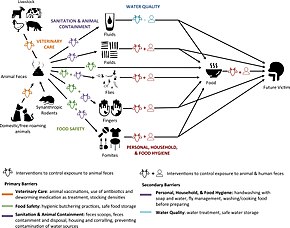
Fecal–oral route

The fecal–oral route (also called the oral–fecal route or orofecal route) describes a particular route of transmission of a disease wherein pathogens in fecal particles pass from one person to the mouth of another person. Main causes of fecal–oral disease transmission include lack of adequate sanitation (leading to open defecation), and poor hygiene practices. If soil or water bodies are polluted with fecal material, humans can be infected with waterborne diseases or soil-transmitted diseases. Fecal contamination of food is another form of fecal-oral transmission. Washing hands properly after changing a baby's diaper or after performing anal hygiene can prevent foodborne illness from spreading.
The common factors in the fecal-oral route can be summarized as five Fs: fingers, flies, fields, fluids, and food. Diseases caused by fecal-oral transmission include typhoid, cholera, polio, hepatitis and many other infections, especially ones that cause diarrhea.
Background


Although fecal–oral transmission is usually discussed as a route of transmission, it is actually a specification of the entry and exit portals of the pathogen, and can operate across several of the other routes of transmission. Fecal–oral transmission is primarily considered as an indirect contact route through contaminated food or water. However, it can also operate through direct contact with feces or contaminated body parts, such as through anal sex. It can also operate through droplet or airborne transmission through the toilet plume from contaminated toilets.
F-diagram
The foundations for the "F-diagram" being used today were laid down in a publication by the World Health Organization (WHO) in 1958. This publication explained transmission routes and barriers to the transmission of diseases from the focal point of human feces.
Modifications have been made over the course of history to derive modern-looking F-diagrams. These diagrams are used in many sanitation publications. They are set up in a way that fecal–oral transmission pathways are shown to take place via water, hands, arthropods and soil. To make it easier to remember, words starting with the letter "F" are used for each of these pathways, namely fluids, fingers, flies, food, fields, fomites (objects and household surfaces).
Rather than only concentrating on human feces, animal feces should also be included in the F-diagram.
The sanitation and hygiene barriers when placed correctly prevent the transmission of an infection through hands, water and food. The F-diagram can be used to show how proper sanitation (in particular toilets, hygiene, handwashing) can act as an effective barrier to stop transmission of diseases via fecal–oral pathways.
Examples
Transmission
The process of transmission may be simple or involve multiple steps. Some examples of routes of fecal–oral transmission include:
- water that has come in contact with feces (for example due to groundwater pollution from pit latrines) and is then not treated properly before drinking;
- by shaking someone's hand that has been contaminated by stool, changing a child's diapers, working in the garden, or dealing with domestic animals.
- food that has been prepared in the presence of fecal matter;
- eating soil (geophagia)
- disease vectors, like houseflies, spreading contamination from inadequate fecal disposal such as open defecation;
- poor or absent hand washing after using the toilet or changing diapers;
- poor or absent cleaning of anything that has been in contact with feces;
- sexual practices that may involve oral contact with feces, such as anilingus ("rimjobs"), coprophilia or A2M sexual intercourse.
- eating feces, in children, or in a mental disorder called coprophagia
Prevention
One approach to changing people's behaviors and stopping open defecation is the community-led total sanitation approach. In this process "live demonstrations" of flies moving from food to fresh human feces and back are used. This can "trigger" villagers into action.
Diseases
The list below shows the main diseases that can be passed via the fecal–oral route. They are grouped by the type of pathogen involved in disease transmission.
Bacteria
- Vibrio cholerae (cholera)
- Clostridium difficile (pseudomembranous enterocolitis)
- Shigella (shigellosis / bacillary dysentery)
- Salmonella typhii (typhoid fever)
- Vibrio parahaemolyticus
- Escherichia coli
- Campylobacter
Viruses
- Hepatitis A
- Hepatitis E
- Enteroviruses
- Norovirus acute gastroenteritis
- Poliovirus (poliomyelitis)
- Although most human Coronaviruses are not transmitted fecally (Feline coronavirus, in contrast, is), there have also been reports of SARS-CoV-2 being found in stool samples.
- Rotavirus gastroenteritis
- Adenovirus gastroenteritis
Protozoans
- Entameba histolytica (amoebiasis / amoebic dysentery)
- Giardia (giardiasis)
- Cryptosporidium (cryptosporidiosis)
- Toxoplasma gondii (toxoplasmosis)
Helminths
Related diseases
Waterborne diseases are diseases caused by pathogenic microorganisms that most commonly are transmitted in contaminated fresh water. This is one particular type of fecal-oral transmission.
Neglected tropical diseases also include many diseases transmitted via the fecal-oral route.
See also
| General |
|
||||||
|---|---|---|---|---|---|---|---|
| Preventive healthcare | |||||||
| Population health | |||||||
| Biological and epidemiological statistics |
|||||||
| Infectious and epidemic disease prevention |
|||||||
| Food hygiene and safety management |
|||||||
| Health behavioral sciences |
|||||||
| Organizations, education and history |
|
||||||
|
Concepts in infectious disease
| |||||||||||
|---|---|---|---|---|---|---|---|---|---|---|---|
| Determinants |
|
||||||||||
| Transmission |
|
||||||||||
| Prevention and Control measures |
|
||||||||||
| Emerging infections | |||||||||||
| Other | |||||||||||
